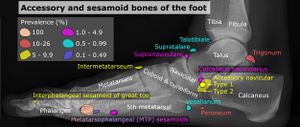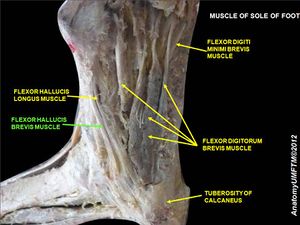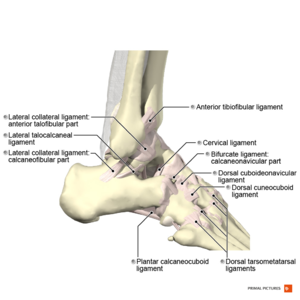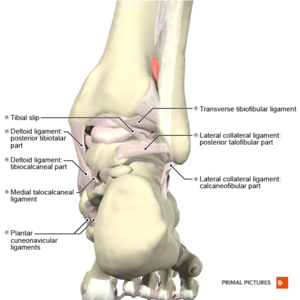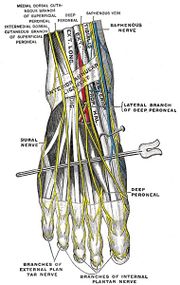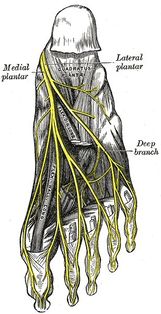Ankle and Foot: Difference between revisions
No edit summary |
Kim Jackson (talk | contribs) m (Text replacement - "[[Shin-splints" to "[[Medial Tibial Stress Syndrome") |
||
| (45 intermediate revisions by 8 users not shown) | |||
| Line 1: | Line 1: | ||
<div class="editorbox">'''Original Editor '''- [[User:Rachael Lowe|Rachael Lowe]] '''Top Contributors''' - {{Special:Contributors/{{FULLPAGENAME}}}}</div> | |||
== Anatomy == | == Anatomy == | ||
The ankle is the part of the lower limb encompassing the distal portion of the leg and proximal portions of the foot. The ankle encompasses the [[Ankle Joint|ankle joint]], an articulation between the tibia and fibula of the leg and the talus of the foot | The [[Ankle Joint|ankle]] is the part of the lower limb encompassing the distal portion of the leg and proximal portions of the foot. The [[Ankle Joint|ankle]] encompasses the [[Ankle Joint|ankle joint]], an articulation between the [[tibia]] and [[fibula]] of the leg and the [[talus]] of the [[Foot Anatomy|foot]]. See the page for [[Ankle Joint|ankle joint]] for more information. | ||
The foot is the part of the lower limb distal to the ankle joint. It is covered on its dorsal surface by loosely adherent skin and on its plantar/inferior surface by thick hairless skin that is tough and strongly adherent to the underlying plantar aponeurosis. The foot contains 26 small bones that are designed for weight bearing and force distribution. The bony alignment creates three arches the provide efficient weight distribution while avoiding compression of plantar neuro-vascular structures. The three arches, medial and lateral longitudinal and the transverse arch together create an architectural vault, which is one of the strongest load-bearing structures known to mankind. | The [[Foot Anatomy|foot]] is the part of the lower limb distal to the [[Ankle Joint|ankle joint]]. It is covered on its dorsal surface by loosely adherent skin and on its plantar/inferior surface by thick hairless skin that is tough and strongly adherent to the underlying plantar aponeurosis. The [[Foot Anatomy|foot]] contains 26 small bones that are designed for weight bearing and force distribution. The bony alignment creates three arches the provide efficient weight distribution while avoiding compression of plantar neuro-vascular structures. The three arches, [https://physio-pedia.com/Foot_and_Ankle_Structure_and_Function?utm_source=physiopedia&utm_medium=search&utm_campaign=ongoing_internal medial and lateral longitudinal and the transverse arch] together create an architectural vault, which is one of the strongest load-bearing structures known to mankind.<ref>The Editors of Encyclopaedia Britannica. Foot. Available from: https://www.britannica.com/science/foot (accessed 26/02/2019).</ref> | ||
== Bones == | == Bones == | ||
The bones of the foot are named as follows: | The bones of the foot are named as follows:[[File:Accessory and sesamoid bones of the foot - lateral projection.jpg|thumb]] | ||
* The tarsals - [[Talus]], [[calcaneus]], [[navicular]], cuboid, cuneiforms (medial, intermediate and lateral) | |||
* The metatarsals - numbered from medial or first (big toe), to lateral or fifth (little toe) | |||
* The phalanges - toes 2-5 each have 3 phalanges. The first or big toe (hallux) has only two <ref>Schmidler C. Anatomy of the Foot and Ankle & Common Problems. Available from: https://www.healthpages.org/anatomy-function/anatomy-foot-ankle/ (accessed: 25/02/2019)</ref> | |||
== Muscles == | |||
[[File:Slide9ZZZZ.JPG|thumb|Foot muscles]] | |||
The dorsum of the [[Foot Anatomy|foot]] has only one muscle (maybe 2 depending on classification). This is the extensor digitorum brevis (some authors name the most medial part of this muscle extensor hallucis brevis). Tendons are the main collagenous structures in the dorsum. The tendons connect anterior/dorsiflexor compartment muscles of the leg to the foot bones. | |||
The plantar aspect of the foot contains the tough fibrous plantar aponeurosis covering muscles and tendons arranged in 4 layers, numbered from 1 superficial to 4 deep: | |||
# Layer 1 consists of the [[Abductor Digiti Minimi (Hand)|abductor didgiti minimi]], flexor digitorum brevis, abductor hallucis | |||
# Layer 2 consists of the [[Quadratus Plantae|quadratus plantae]], the lumbricals, and the long tendons of [[flexor digitorum longus]] and [[flexor hallucis longus]] | |||
# Layer 3 consists of the [https://physio-pedia.com/Flexor_Hallucis_Brevis?utm_source=physiopedia&utm_medium=search&utm_campaign=ongoing_internal flexor hallucis brevis], [https://physio-pedia.com/Adductor_Hallucis?utm_source=physiopedia&utm_medium=search&utm_campaign=ongoing_internal adductor hallucis] and [https://physio-pedia.com/Flexor_Digiti_Minimi_Brevis?utm_source=physiopedia&utm_medium=search&utm_campaign=ongoing_internal flexor digiti minimi brevis] | |||
# Layer 4 consists of the interosseous muscles and the long tendons of [[Peroneus (Fibularis) Longus Muscle|peroneus/fibularis longus]] and [[Tibialis Posterior|tibialis posterior]]<ref>Arthritis Foundation. Anatomy of the foot. Available from: [https://www.arthritis.org/health-wellness/about-arthritis/where-it-hurts/anatomy-of-the-foot https://www.arthritis/where-it-hurts/foot-heel-and-toe-pain/foot-anatomy.php] (accessed 25/02/2019).</ref> | |||
== Ligaments == | |||
[[Ankle Joint|Ankle]] ligament injury is the most frequent cause of acute ankle pain. Hence, it is important to understand the anatomy of ankle ligaments for correct diagnosis and treatment. | |||
The ligaments around the ankle can be divided, depending on their anatomic position, into three groups: the lateral ligaments, the deltoid ligament on the medial side, and the ligaments of the tibiofibular syndesmosis that join the distal epiphyses of the tibia and fibula.<ref name=":0">Golanó P, Vega J, De Leeuw PA, Malagelada F, Manzanares MC, Götzens V, Van Dijk CN. [https://www.ncbi.nlm.nih.gov/pmc/articles/PMC2855022/ Anatomy of the ankle ligaments: a pictorial essay.] Knee Surgery, Sports Traumatology, Arthroscopy 2010;18(5):557-69.</ref> | |||
The [[Lateral Collateral Ligament of the Knee|lateral collateral ligament complex (LCL)]] consists of<ref name=":0" />: | |||
[[File:Ligaments of the ankle lateral aspect Primal.png|right|frameless]] | |||
# Anterior talofibular ligament: it is the most frequently injured ligament of the [[Ankle Joint|ankle]]. This ligament plays an important role in limiting anterior displacement of the [[talus]] and plantar flexion of the [[Ankle Joint|ankle]]. | |||
# Posterior talofibular ligament: The posterior talofibular ligament originates from the malleolar fossa, located on the medial surface of the lateral malleolus, coursing almost horizontally to insert in the posterolateral talus. It is the strongest ligament of the lateral ankle. plays only a supplementary role in ankle stability when the lateral ligament complex is intact. | |||
# Calcaneofibular ligament: The calcaneofibular ligament originates from the anterior part of the lateral malleolus. Its primary role is to restrain inversion in a neutral or dorsiflexed position, restrains subtalar inversion, thereby limiting talar tilt within the ankle mortise.[[File:Ligaments of the ankle posterior aspect Primal.png|right|frameless]] | |||
The [[Medial Collateral Ligament Injury of the Knee|medial collateral ligament (MCL)]], also known as deltoid ligament, is composed of two layers; superficial and deep. The MCL is a multifascicular ligament, originating from the medial malleolus to insert in the [[talus]], [[calcaneus]], and navicular bone. It primary restrains to valgus tilting of the [[talus]]. Both the superficial and deep layers individually resist eversion of the hindfoot. It also stabilizes [[Ankle Joint|ankle]] against plantar flexion, external rotation, and pronation.<ref name=":0" /> | |||
The ligaments of the tibiofibular syndesmosis consist of anterior or anteroinferior tibiofibular ligament, the posterior or posteroinferior tibiofibular ligament, and the interosseous tibiofibular ligament. The syndesmotic ligament complex ensures the stability between the distal [[tibia]] and the [[fibula]] and resists the axial, rotational, and translational forces that attempt to separate the [[tibia]] and [[fibula]].<ref name=":0" /> | |||
== Neurovasculature == | |||
[[File:Gray836.jpg|thumb|285x285px|Nerves of the dorsum of the foot]] | |||
[[File:Gray833 (1).jpg|thumb|314x314px|The plantar nerves]] | |||
Cutaneous innervation of the dorsum is by the superficial and deep peroneal/fibular nerves. Cutaneous innervation of the plantar aspect is by the medial and lateral plantar and tibial nerves. Dorsal motor innervation is by the deep peroneal nerve to extensor digitorum brevis and extensor hallucis brevis. Plantar motor innervation is via the medial and lateral plantar nerves (terminal branches of the tibial nerve). Arteries crossing into the foot accompany nerves of corresponding names. Therefore the anterior tibial or [[Dorsalis Pedis Artery|dorsalis pedis artery]], and the posterior tibial artery, are the terminal branches of the medial and lateral plantar arteries.<ref>Hernández-Díaz C, Saavedra MÁ, Navarro-Zarza JE, Canoso JJ, Villasenor-Ovies P, Vargas A, Kalish RA. [https://www.sciencedirect.com/science/article/pii/S1699258X12002434 Clinical anatomy of the ankle and foot.] Reumatologia clinica 2012;8:46-52.</ref> | |||
== Clinical Examination == | |||
=== [[Foot and Ankle Assessment-Investigations and Tests|Ankle & Foot Examination]] === | |||
==== Special Tests ==== | |||
* [[Anterior Drawer of the Ankle|Anterior drawer of the ankle]] | |||
{{#ev:youtube|Z4rvAT3a7OY|300}}<ref>CRTecnologies. Anterior Drawer Test Ankle. Available from:https://www.youtube.com/watch?v=Z4rvAT3a7OY [last accessed 30/6/2021]</ref> | |||
* [[Stress tests for Ankle ligaments|Ligament Tests]] | |||
{{#ev:youtube|2qF_DOe2jPE|300}}<ref>bigesor. Talar Tilt Test. Available from: https://www.youtube.com/watch?v=2qF_DOe2jPE [last accessed 30/6/2021]</ref> | |||
*[[Squeeze Test|Squeeze Test]] | |||
{{#ev:youtube|rM9Rk1oucHM|300}} <ref>Physical Therapy Nation.Syndesmosis Squeeze Test. Available from: https://www.youtube.com/watch?v=rM9Rk1oucHM [last accessed 30/6/2021]</ref> | |||
*[[Ankle and Foot Mobilisations|Kaltenborn Foot & Ankle]] | |||
*[[Windlass Test|Windlass test]] | |||
<div class="row"> | |||
<div class="col-md-6"> {{#ev:youtube|iQD5qtO5-zE|250}} <div class="text-right"><ref>Daryl Lawson. Windlass Test Nonweightbearing. Available from:https://www.youtube.com/watch?v=iQD5qtO5-zE[last accessed 30/6/2021]</ref></div></div> | |||
<div class="col-md-6"> {{#ev:youtube|ZO0wREhjxH0|250}} <div class="text-right"><ref>Kate Cornet. Windlass Test. Available from: https://www.youtube.com/watch?v=ZO0wREhjxH0 [last accessed 30/6/2021]</ref></div></div> | |||
==== Outcome Measures ==== | |||
# [[Foot and Ankle Disability Index|Foot and Ankle Disability Index]] | |||
# [[Foot Function Index (FFI)]]<ref>Alazzawi S, Sukeik M, King D, Vemulapalli K. [https://www.ncbi.nlm.nih.gov/pmc/articles/PMC5241541/ Foot and ankle history and clinical examination: A guide to everyday practice.] World Journal of Orthopedics 2017;8(1):21–29.</ref><ref>Fraser JJ, Koldenhoven RM, Saliba SA, Hertel J. [https://www.ncbi.nlm.nih.gov/pmc/articles/PMC5717489/ Reliability of ankle-foot morphology, mobility, strength, and motor performance measures.] International Journal of Sports Physical Therapy 2017 Dec;12(7):1134.</ref><ref>Martin RL, Davenport TE, Reischl SF, McPoil TG, Matheson JW, Wukich DK, McDonough CM, Altman RD, Beattie P, Cornwall M, Davis I. [https://www.jospt.org/doi/full/10.2519/jospt.2014.0303 Heel pain—plantar fasciitis: revision 2014.] Journal of Orthopaedic & Sports Physical Therapy 2014;44(11):A1-33.</ref> | |||
== Conditions == | == Conditions == | ||
*[[Achilles Tendonitis|Achilles | |||
*[[Achilles Rupture|Achilles | *[[Achilles Tendonitis|Achilles tendonitis]] | ||
*[[Ankle & Foot Fractures|Ankle & | *[[Achilles Rupture|Achilles rupture]] | ||
*[[Ankle & Foot Arthropathies|Ankle & | *[[Ankle & Foot Fractures|Ankle & foot fractures]] | ||
*[[Ankle Sprain|Ankle | *[[Ankle & Foot Arthropathies|Ankle & foot arthropathies]] | ||
*[[Ankle Sprain|Ankle sprain]] | |||
*[[Ankle Impingement|Ankle Impingement]] | *[[Ankle Impingement|Ankle Impingement]] | ||
*[[Ankle Impingement | *[[Anterior Ankle Impingement Syndrome|Anterior ankle impingement syndrome]] | ||
*[[Ankle Osteochondral Lesions|Ankle | *[[Ankle Osteochondral Lesions|Ankle ssteochondral lesions]] | ||
*[[Calcaneal Fractures|Calcaneal | *[[Calcaneal Fractures|Calcaneal fractures]] | ||
*[[Calcaneal Spurs|Calcaneal | *[[Calcaneal Spurs|Calcaneal spurs]] | ||
*[[Compartment Syndrome of the Foot|Compartment | *[[Compartment Syndrome of the Foot|Compartment syndrome of the foot]] | ||
*[[Compartment Syndrome of the Lower Leg|Compartment | *[[Compartment Syndrome of the Lower Leg|Compartment syndrome of the lower leg]] | ||
*[[Calf Strain|Calf | *[[Calf Strain|Calf strain]] | ||
*[[Hallux Valgus|Hallux | *[[Hallux Valgus|Hallux valgus]] | ||
*[[Hallux Rigiditus|Hallux | *[[Hallux Rigiditus|Hallux rigiditus]] | ||
*[[Lisfranc Injuries|Lisfranc | *[[Lisfranc Injuries|Lisfranc injuries]] | ||
*[[Metatarsalgia|Metatarsalgia]] | *[[Metatarsalgia|Metatarsalgia]] | ||
*[[Peroneal Tendonitis|Peroneal | *[[Peroneal Tendonitis|Peroneal rendonitis]] | ||
*[[Plantarfasciitis|Plantarfasciitis]] | *[[Plantarfasciitis|Plantarfasciitis]] | ||
*[[Posterior Tibial Tendon Dysfunction|Posterior | *[[Posterior Tibial Tendon Dysfunction|Posterior tibial tendon dysfunction]] | ||
*[[Retrocalcaneal Bursitis|Retrocalcaneal | *[[Retrocalcaneal Bursitis|Retrocalcaneal bursitis]] | ||
*[[Shin | *[[Medial Tibial Stress Syndrome|Shin splints]] | ||
*[[Sinus Tarsi Syndrome|Sinus | *[[Sinus Tarsi Syndrome|Sinus tarsi syndrome]] | ||
*[[Tarsal Tunnel | *[[Tarsal Tunnel Syndrome|Tarsal tunnel syndrome]] | ||
*[[Tibiofibular Diastasis|Tibiofibular | *[[Tibiofibular Diastasis|Tibiofibular diastasis]]<ref>American College of Foot and Ankle Surgeons. Browse Foot & Ankle Conditions. Available from: https://www.foothealthfacts.org/foot-ankle-conditions/browse-foot-ankle-conditions (accessed 25/02/2019).</ref> | ||
== Procedures == | == Procedures == | ||
*[[Total Ankle Arthroplasty|Total ankle arthroplasty]]<ref>Coster C.D, Bradly J, Solorzano J, Buxton S, Williams D. Total Ankle Arthroplasty. Available from: [[Total Ankle Arthroplasty|https://www.physio-pedia.com/Total_Ankle_Arthroplasty]] (accessed 25.02.2019)</ref> | |||
== References == | |||
<references /> | |||
[[Category:Ankle]] | |||
[[Category:Foot]] | |||
[[Category:Anatomy]] | [[Category:Anatomy]] | ||
[[Category:Ankle | [[Category:Ankle - Anatomy]] | ||
[[Category:Ankle - Bones]] | |||
[[Category:Ankle - Muscles]] | |||
[[Category:Ankle - Ligaments]] | |||
[[Category:Foot - Anatomy]] | |||
[[Category:Foot - Bones]] | |||
[[Category:Foot - Muscles]] | |||
[[Category:Foot - Ligaments]] | |||
Latest revision as of 09:30, 1 June 2022
Anatomy [edit | edit source]
The ankle is the part of the lower limb encompassing the distal portion of the leg and proximal portions of the foot. The ankle encompasses the ankle joint, an articulation between the tibia and fibula of the leg and the talus of the foot. See the page for ankle joint for more information.
The foot is the part of the lower limb distal to the ankle joint. It is covered on its dorsal surface by loosely adherent skin and on its plantar/inferior surface by thick hairless skin that is tough and strongly adherent to the underlying plantar aponeurosis. The foot contains 26 small bones that are designed for weight bearing and force distribution. The bony alignment creates three arches the provide efficient weight distribution while avoiding compression of plantar neuro-vascular structures. The three arches, medial and lateral longitudinal and the transverse arch together create an architectural vault, which is one of the strongest load-bearing structures known to mankind.[1]
Bones[edit | edit source]
The bones of the foot are named as follows:
- The metatarsals - numbered from medial or first (big toe), to lateral or fifth (little toe)
- The phalanges - toes 2-5 each have 3 phalanges. The first or big toe (hallux) has only two [2]
Muscles[edit | edit source]
The dorsum of the foot has only one muscle (maybe 2 depending on classification). This is the extensor digitorum brevis (some authors name the most medial part of this muscle extensor hallucis brevis). Tendons are the main collagenous structures in the dorsum. The tendons connect anterior/dorsiflexor compartment muscles of the leg to the foot bones.
The plantar aspect of the foot contains the tough fibrous plantar aponeurosis covering muscles and tendons arranged in 4 layers, numbered from 1 superficial to 4 deep:
- Layer 1 consists of the abductor didgiti minimi, flexor digitorum brevis, abductor hallucis
- Layer 2 consists of the quadratus plantae, the lumbricals, and the long tendons of flexor digitorum longus and flexor hallucis longus
- Layer 3 consists of the flexor hallucis brevis, adductor hallucis and flexor digiti minimi brevis
- Layer 4 consists of the interosseous muscles and the long tendons of peroneus/fibularis longus and tibialis posterior[3]
Ligaments[edit | edit source]
Ankle ligament injury is the most frequent cause of acute ankle pain. Hence, it is important to understand the anatomy of ankle ligaments for correct diagnosis and treatment.
The ligaments around the ankle can be divided, depending on their anatomic position, into three groups: the lateral ligaments, the deltoid ligament on the medial side, and the ligaments of the tibiofibular syndesmosis that join the distal epiphyses of the tibia and fibula.[4]
The lateral collateral ligament complex (LCL) consists of[4]:
- Anterior talofibular ligament: it is the most frequently injured ligament of the ankle. This ligament plays an important role in limiting anterior displacement of the talus and plantar flexion of the ankle.
- Posterior talofibular ligament: The posterior talofibular ligament originates from the malleolar fossa, located on the medial surface of the lateral malleolus, coursing almost horizontally to insert in the posterolateral talus. It is the strongest ligament of the lateral ankle. plays only a supplementary role in ankle stability when the lateral ligament complex is intact.
- Calcaneofibular ligament: The calcaneofibular ligament originates from the anterior part of the lateral malleolus. Its primary role is to restrain inversion in a neutral or dorsiflexed position, restrains subtalar inversion, thereby limiting talar tilt within the ankle mortise.
The medial collateral ligament (MCL), also known as deltoid ligament, is composed of two layers; superficial and deep. The MCL is a multifascicular ligament, originating from the medial malleolus to insert in the talus, calcaneus, and navicular bone. It primary restrains to valgus tilting of the talus. Both the superficial and deep layers individually resist eversion of the hindfoot. It also stabilizes ankle against plantar flexion, external rotation, and pronation.[4]
The ligaments of the tibiofibular syndesmosis consist of anterior or anteroinferior tibiofibular ligament, the posterior or posteroinferior tibiofibular ligament, and the interosseous tibiofibular ligament. The syndesmotic ligament complex ensures the stability between the distal tibia and the fibula and resists the axial, rotational, and translational forces that attempt to separate the tibia and fibula.[4]
Neurovasculature[edit | edit source]
Cutaneous innervation of the dorsum is by the superficial and deep peroneal/fibular nerves. Cutaneous innervation of the plantar aspect is by the medial and lateral plantar and tibial nerves. Dorsal motor innervation is by the deep peroneal nerve to extensor digitorum brevis and extensor hallucis brevis. Plantar motor innervation is via the medial and lateral plantar nerves (terminal branches of the tibial nerve). Arteries crossing into the foot accompany nerves of corresponding names. Therefore the anterior tibial or dorsalis pedis artery, and the posterior tibial artery, are the terminal branches of the medial and lateral plantar arteries.[5]
Clinical Examination[edit | edit source]
Ankle & Foot Examination[edit | edit source]
Special Tests[edit | edit source]
Outcome Measures[edit | edit source]
Conditions[edit | edit source]
- Achilles tendonitis
- Achilles rupture
- Ankle & foot fractures
- Ankle & foot arthropathies
- Ankle sprain
- Ankle Impingement
- Anterior ankle impingement syndrome
- Ankle ssteochondral lesions
- Calcaneal fractures
- Calcaneal spurs
- Compartment syndrome of the foot
- Compartment syndrome of the lower leg
- Calf strain
- Hallux valgus
- Hallux rigiditus
- Lisfranc injuries
- Metatarsalgia
- Peroneal rendonitis
- Plantarfasciitis
- Posterior tibial tendon dysfunction
- Retrocalcaneal bursitis
- Shin splints
- Sinus tarsi syndrome
- Tarsal tunnel syndrome
- Tibiofibular diastasis[14]
Procedures[edit | edit source]
References[edit | edit source]
- ↑ The Editors of Encyclopaedia Britannica. Foot. Available from: https://www.britannica.com/science/foot (accessed 26/02/2019).
- ↑ Schmidler C. Anatomy of the Foot and Ankle & Common Problems. Available from: https://www.healthpages.org/anatomy-function/anatomy-foot-ankle/ (accessed: 25/02/2019)
- ↑ Arthritis Foundation. Anatomy of the foot. Available from: https://www.arthritis/where-it-hurts/foot-heel-and-toe-pain/foot-anatomy.php (accessed 25/02/2019).
- ↑ 4.0 4.1 4.2 4.3 Golanó P, Vega J, De Leeuw PA, Malagelada F, Manzanares MC, Götzens V, Van Dijk CN. Anatomy of the ankle ligaments: a pictorial essay. Knee Surgery, Sports Traumatology, Arthroscopy 2010;18(5):557-69.
- ↑ Hernández-Díaz C, Saavedra MÁ, Navarro-Zarza JE, Canoso JJ, Villasenor-Ovies P, Vargas A, Kalish RA. Clinical anatomy of the ankle and foot. Reumatologia clinica 2012;8:46-52.
- ↑ CRTecnologies. Anterior Drawer Test Ankle. Available from:https://www.youtube.com/watch?v=Z4rvAT3a7OY [last accessed 30/6/2021]
- ↑ bigesor. Talar Tilt Test. Available from: https://www.youtube.com/watch?v=2qF_DOe2jPE [last accessed 30/6/2021]
- ↑ Physical Therapy Nation.Syndesmosis Squeeze Test. Available from: https://www.youtube.com/watch?v=rM9Rk1oucHM [last accessed 30/6/2021]
- ↑ Daryl Lawson. Windlass Test Nonweightbearing. Available from:https://www.youtube.com/watch?v=iQD5qtO5-zE[last accessed 30/6/2021]
- ↑ Kate Cornet. Windlass Test. Available from: https://www.youtube.com/watch?v=ZO0wREhjxH0 [last accessed 30/6/2021]
- ↑ Alazzawi S, Sukeik M, King D, Vemulapalli K. Foot and ankle history and clinical examination: A guide to everyday practice. World Journal of Orthopedics 2017;8(1):21–29.
- ↑ Fraser JJ, Koldenhoven RM, Saliba SA, Hertel J. Reliability of ankle-foot morphology, mobility, strength, and motor performance measures. International Journal of Sports Physical Therapy 2017 Dec;12(7):1134.
- ↑ Martin RL, Davenport TE, Reischl SF, McPoil TG, Matheson JW, Wukich DK, McDonough CM, Altman RD, Beattie P, Cornwall M, Davis I. Heel pain—plantar fasciitis: revision 2014. Journal of Orthopaedic & Sports Physical Therapy 2014;44(11):A1-33.
- ↑ American College of Foot and Ankle Surgeons. Browse Foot & Ankle Conditions. Available from: https://www.foothealthfacts.org/foot-ankle-conditions/browse-foot-ankle-conditions (accessed 25/02/2019).
- ↑ Coster C.D, Bradly J, Solorzano J, Buxton S, Williams D. Total Ankle Arthroplasty. Available from: https://www.physio-pedia.com/Total_Ankle_Arthroplasty (accessed 25.02.2019)
